ACL Tear & Injury: Understanding the Condition and Treatment Options
ACL injuries are not just painful — they can severely impact mobility and long-term knee stability. Dr Foo offers expert diagnosis and customised treatment plans to help patients return to an active lifestyle safely.
MBBS (University of London) | MMed (Ortho) | FRCSEd (Ortho) | FAMS (Ortho)


What Is an ACL Tear?
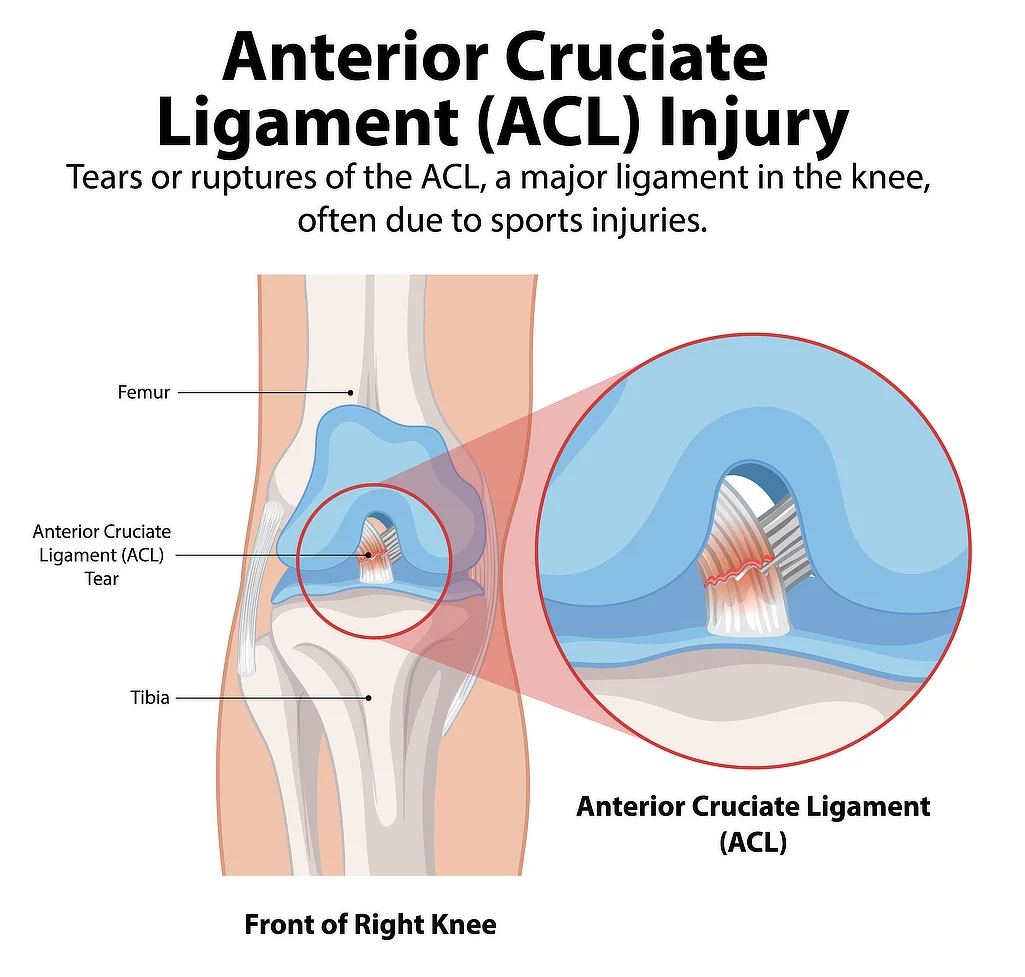
An ACL tear is an injury to the anterior cruciate ligament, which occurs when the ligament
is stretched beyond its capacity, either partially or completely rupturing.
The ACL is one of 4 major ligaments that stabilise the knee joint,
connecting the femur
(thighbone) to the tibia (shinbone) and preventing excessive forward movement and rotational
instability.
The others include the posterior cruciate ligament (PCL), which prevents
backward movement of the tibia; the medial collateral ligament (MCL), stabilising the inner
knee; and the lateral collateral ligament (LCL), stabilising the outer knee.
ACL tears are particularly common among athletes involved in sports that
require sudden changes in direction, jumping, or pivoting.
ACL Tear Symptoms
Individuals with an ACL tear often experience a range of symptoms that can significantly impact their mobility and daily activities. Common signs include:
- "Popping" sound at the time of injury due to the sudden tearing of ACL fibres.
- Sudden, severe knee pain resulting from damage to the ligament and surrounding tissue.
- Swelling within hours of the injury caused by the build-up of blood in the joint from torn blood vessels in the ligament.
- Instability or a feeling of the knee "giving way" due to the ligament's inability to stabilise the knee, leading to a loss of control during movement.
- Reduced range of motion caused by swelling, pain, and tissue damage that limit the knee's ability to bend or straighten fully.
What Causes ACL Tears?
ACL tears typically occur when the ligament is overstretched or torn due to abrupt movements or direct impact. These injuries are especially common in sports involving sudden stops, directional changes, or collisions.

Common causes include:
- Sudden deceleration or stopping – Abruptly halting forward motion can place extreme tension on the ACL, especially during high-speed activities or sports.
- Pivoting or twisting movements – Sharp turns while the foot remains planted can cause the ligament to twist beyond its normal range.
- Landing awkwardly from a jump – Landing unevenly or with poor form after a jump can overload the ACL.
- Direct trauma to the knee – Blows from contact sports or falls can knock the joint out of alignment, can force the joint out of alignment, causing ligament damage.
Certain factors can increase the likelihood of an ACL tear:
- Participation in high-impact sports like soccer, basketball, or skiing.
- Inadequate conditioning or training techniques.
- Suboptimal movement techniques, such as poor landing or cutting during sudden direction changes.
- Female athletes may have a higher risk due to anatomical and hormonal differences.
Types of ACL Injuries
ACL injuries can vary in severity and are generally classified into three main grades based on the extent of ligament damage:
- Grade 1 Sprain – The ligament is stretched but remains intact, with minor damage to its fibres. Stability is usually maintained, though there may be mild discomfort and swelling.
- Grade 2 Partial Tear – The ligament is partially torn, causing moderate pain, swelling, and instability. This type of injury is less common but may significantly affect knee function.
- Grade 3 Complete Tear – The ligament is completely torn into two pieces, leading to significant pain, swelling, and instability.
Additionally, ACL injuries may occur alongside damage to other structures in the knee, such as the meniscus or collateral ligaments, known as complex or multi-ligament injuries.
Complications of ACL Injury
If left untreated, ACL injuries may lead to long-term complications, including chronic knee instability,
frequent episodes of the knee "giving way," and increased risk of meniscus tears or cartilage
damage.
Over time, these issues may contribute to early-onset osteoarthritis, significantly
affecting knee function, mobility, and quality of life, particularly as you age.
ACL Tear Diagnosis Tests
Diagnosing an ACL tear typically involves physical assessments and imaging techniques by a doctor or knee specialist to evaluate the injury. Common methods include:
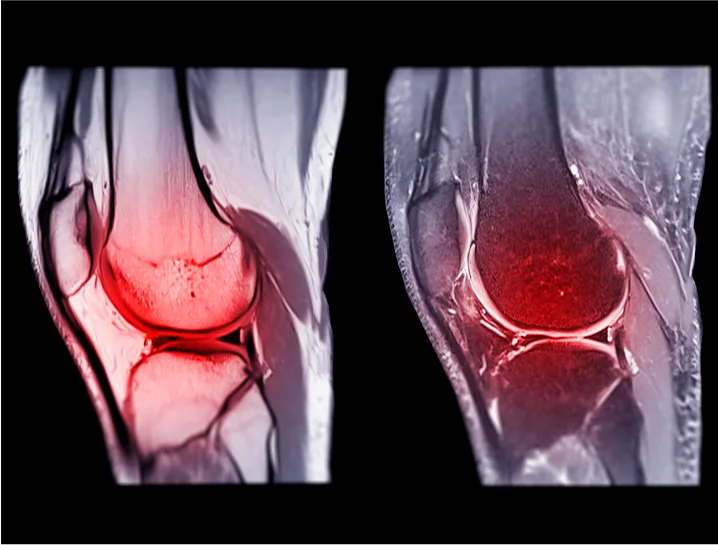
1. Physical Examination
A visual and manual assessment to evaluate swelling, tenderness, joint stability, range of motion, and overall knee condition.
2. Lachman Test
A specialised manual test where the knee is bent at a slight angle, and the tibia is gently pulled forward to evaluate abnormal movement or looseness. This test is widely used to assess ACL integrity.
3. Imaging Tests
Imaging tests are vital in diagnosing an ACL tear and determining the extent of the injury.
- X-rays – Used to rule out fractures or other bone-related injuries that might occur alongside the ACL tear.
- Magnetic Resonance Imaging (MRI) – Provides detailed images of soft tissues, including the ACL, to confirm the tear's severity and assess for additional damage to the meniscus, cartilage, or other ligaments.
ACL Tear & Injury Treatment
Treatment for ACL injuries depends on the severity of the tear, activity level, and
personal
goals.
Options include non-surgical management for partial tears or less active individuals
and surgical intervention for complete tears or those with high activity levels, often
involving a combined approach.
| Treatment | Description & Purpose |
|---|---|
| Non-Surgical Treatments | |
| Swelling & Pain Management | Medications such as anti-inflammatory drugs, cold therapy, and guided pain relief strategies help manage discomfort and support rehabilitation. RICE therapy (Rest, Ice, Compression, Elevation) is recommended early to reduce swelling, support healing, and prevent further strain on the knee. |
| Supportive Bracing | Functional knee braces provide stability during movement, reducing strain on the ACL while allowing controlled mobility. Immobiliser braces may be used in the early stages to restrict motion and protect the knee during initial healing. |
| Lifestyle Modifications | Avoiding high-impact activities like running or jumping to prevent further injury, focusing on low-impact exercises to maintain fitness. |
| Physiotherapy | A structured exercise programme to restore knee strength, stability, and mobility, ideal for managing partial tears and preventing further damage. |
| Injection-Based Treatment | Platelet-Rich Plasma (PRP) therapy to stimulate tissue healing and reduce inflammation, hyaluronic acid injections to improve joint lubrication and relieve stiffness, or corticosteroid injections to provide temporary pain relief and manage inflammation. |
| Surgical Intervention | |
| ACL Reconstruction Surgery | A minimally invasive procedure using an arthroscope (a small camera) to replace the damaged ligament with a graft from the hamstring, patellar tendon, or a donor, suitable for complete tears or those returning to high-impact activities. |
| Post-Surgical Rehabilitation | A structured physiotherapy programme to restore full knee function, strength, and range of motion, tailored to individual goals, typically lasting several months. |
ACL Tear Recovery
Recovery time for an ACL injury depends on the severity of the tear and treatment
approach.
Non-surgical recovery for partial tears typically takes 3 to 6 months
with physiotherapy, while ACL reconstruction surgery requires 6 to 12
months
for full rehabilitation.
Factors like age, overall health, and adherence to rehabilitation
influence recovery speed.
Every patient deserves a treatment plan tailored to their needs. We start with non-surgical approaches before considering more invasive interventions.
Where Can I Find an ACL Specialist in Singapore?
Apex Novena
admin@apexsportsclinic.sg
101 Irrawaddy Rd, #18-12 Royal Square Medical Centre, Singapore 329565
Nearest MRT: NS20 Novena
Apex East Coast
admin@apexsportsclinic.sg
112 E Coast Rd, #03-03/04 i12 Katong, Singapore 428802
Nearest MRT: TE26 Marine Parade
Why Do Patients Choose Apex Sports Clinic?
Sports Doctor in Singapore: Personalised & Affordable Care
Progressive Treatment Philosophy
We prioritise personalised, non-invasive solutions, progressing to specialised treatments, including surgery, only when needed for more effective and targeted care.
Holistic Patient-Centred Care
From diagnosis to rehabilitation, we provide comprehensive and seamless care for a wide range of orthopaedic conditions.
Specialist in Sports Orthopaedics & Injury Management
We combine expert injury management with a proactive approach to maintaining your body’s strength and function, so you can recover fully and perform at your peak.
Patient Journey
1 . Schedule Your Appointment
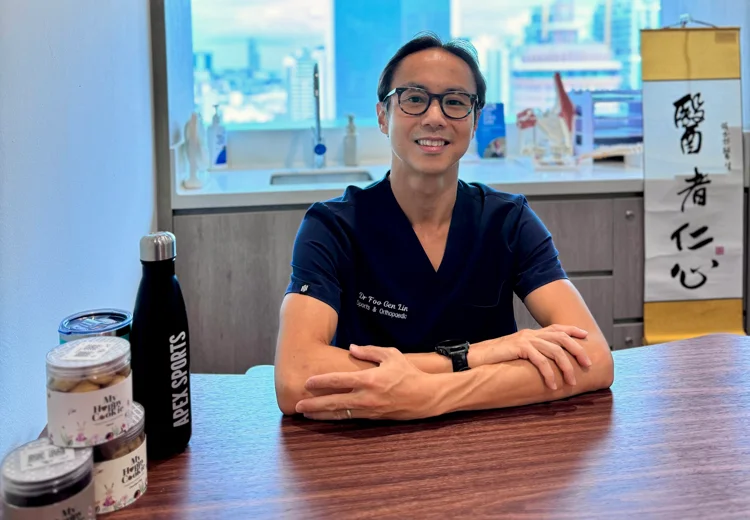
2 . Expert Diagnosis & Consultation
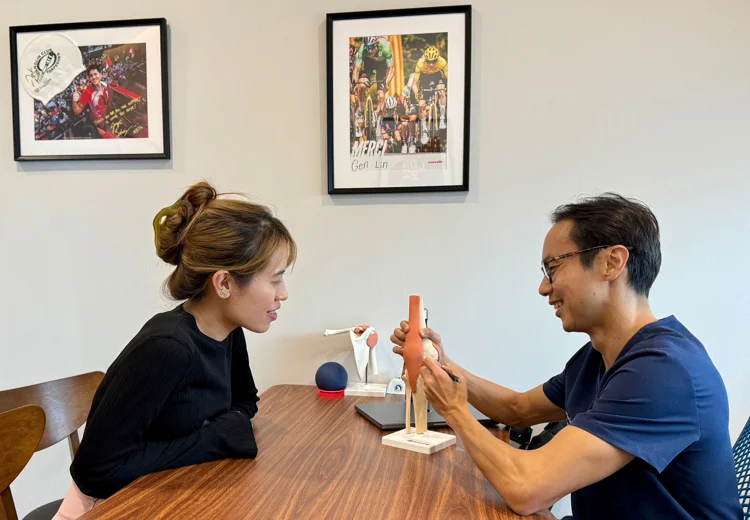
3 . Customised Treatment Plan

Schedule an Appointment
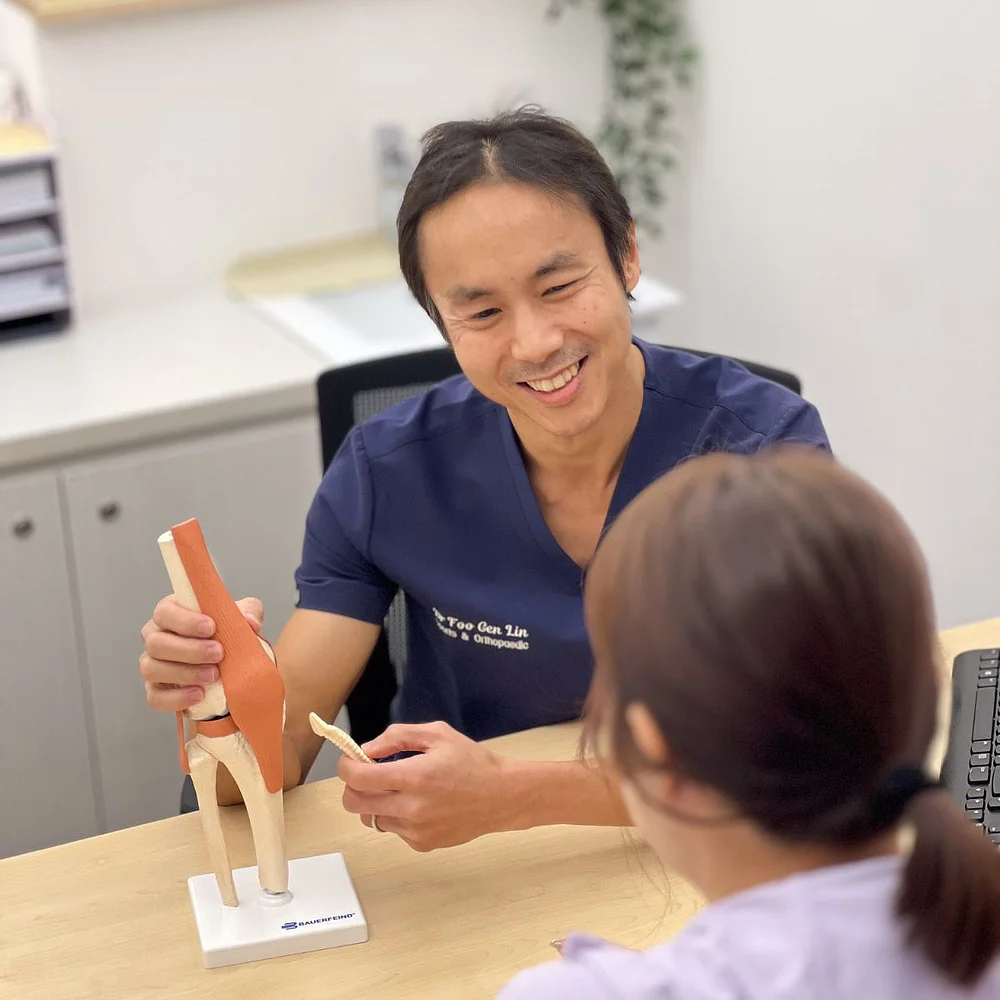
Our Insurance Partners






Frequently Asked Questions (FAQs)
Jogging is typically not recommended with an untreated ACL tear due to knee instability, which may cause further damage. However, it may be possible after recovery and rehabilitation, depending on the severity of the tear and individual progress.
An ACL tear can cause sudden, severe pain at the time of injury, often accompanied by swelling and tenderness.
MRI is generally accurate and widely used for diagnosing ACL tears. However, rare cases of false negatives or positives can occur, often due to poor imaging quality or incorrect interpretation.
Recovery from a grade 3 ACL tear typically takes 6 to 12 months with surgical treatment, depending on rehabilitation progress.
Squats are generally not advisable with a torn ACL, as they can strain the ligament and knee joint, potentially worsening the injury. It is best to wait until a physiotherapist or orthopaedic specialist assesses your knee stability, strength, and rehabilitative progress to confirm it is safe to perform such movements.
The average recovery time for an ACL tear ranges from 6 to 12 months, depending on the severity of the injury, adherence to treatment, and progress during rehabilitation.
Walking on a torn ACL is generally not harmful. However, excessive movement without proper stability can increase the risk of further damage, especially depending on the severity of the tear. It is best to consult a doctor or specialist for personalised guidance.
Low-impact exercises like swimming or cycling are possible with a torn ACL, but high-impact or pivot-heavy activities may worsen instability. It is best to consult a doctor or specialist to determine suitable exercises for your condition and recovery.
ACL tears are caused by sudden deceleration, pivoting, awkward landings, or direct trauma to the knee, often during high-impact sports.
Complete ACL tears do not heal on their own, but partial tears may improve with conservative treatment. It is advisable to consult a doctor or specialist if you suspect an ACL tear or experience persistent or severe knee pain.
It may be possible to bend your knee with a torn ACL, but pain, swelling, or instability can limit range of motion, and improper movement may worsen the injury. It is best to consult your doctor or physiotherapist before attempting such actions.
An ACL sprain involves stretching or minor damage to the ligament, while a tear indicates a complete rupture or partial damage.
Many individuals report hearing or feeling a "pop" at the moment of an ACL tear, often accompanied by sudden pain, swelling, or instability in the knee.
No, an ACL tear does not require knee replacement. Treatment typically involves physiotherapy, bracing, and lifestyle modifications for partial tears. For complete tears, ACL reconstruction surgery is often recommended to restore stability and function, followed by a structured rehabilitation programme.
Recovery from surgery to repair a full ACL tear typically takes 6 to 12 months, depending on the severity of the tear, adherence to rehabilitation, and the individual's overall health.
Signs of an ACL tear include a "popping" sound at the time of injury, severe knee pain, swelling, instability, and reduced range of motion. If you experience these symptoms or suspect a torn ACL, consult a doctor or specialist for evaluation and treatment to avoid long-term complications.
Conservative options include physiotherapy to strengthen surrounding muscles, bracing to stabilise the knee, and lifestyle modifications to avoid high-impact activities. It is best to consult a doctor or specialist to determine the most appropriate treatment for your condition.
Partial ACL injuries may recover naturally with rest, physiotherapy to strengthen surrounding muscles, and bracing for stability. However, complete ACL tears typically require surgical intervention to restore full stability. If you experience severe or persistent knee pain or suspect an ACL injury, it is advisable to consult a doctor or specialist for evaluation.
A re-tear may require revision surgery, which can be more complex and involves longer recovery due to previous scar tissue or graft failure. It is best to consult your doctor or specialist to determine the appropriate course of treatment.
Non-surgical recovery is possible for partial tears or low-activity individuals through physiotherapy, bracing, and lifestyle adjustments. It is advisable to consult a doctor or specialist to determine the most appropriate treatment and prevent complications such as chronic knee instability, further joint damage, or an increased risk of meniscus tears.
While it is possible to live with a torn ACL, it is not medically advisable. A torn ACL can lead to chronic knee instability, increased risk of further injuries, and long-term joint damage, such as osteoarthritis. Consulting a doctor or specialist is essential to assess your condition and explore appropriate treatment options for maintaining knee health and functionality.
Symptoms of an ACL tear include a "pop" sound at the time of injury, swelling, pain, instability, and reduced range of motion. It is best to consult a doctor or specialist if you experience severe or persistent knee pain or suspect an ACL tear to ensure proper evaluation and treatment.
Leaving a torn ACL untreated can lead to chronic instability and increase the risk of further knee damage, such as meniscus tears or cartilage degeneration. If you experience severe or persistent knee pain or suspect an ACL tear, it is advisable to consult a specialist to ensure proper evaluation and treatment to prevent long-term complications.
ACL tear bruising refers to discolouration around the knee or lower leg caused by bleeding in the joint or surrounding tissues following the injury. However, bruising can also result from other knee injuries or trauma, so it is best to consult a doctor for a proper diagnosis.
The average recovery time for an ACL tear ranges from 6 to 12 months, depending on the severity of the injury, adherence to treatment, and progress during rehabilitation.
Complete ACL tears usually require surgery to restore knee stability, especially for active individuals. Non-surgical treatments like physiotherapy and bracing may help those with low activity levels. It is best to consult a doctor or specialist to determine the most suitable treatment.
Partial ACL tears may heal with rest, physiotherapy, and bracing. However, complete tears typically do not heal on their own due to limited blood supply to the ligament and often require surgery.
Preventing ACL tears requires a proactive approach to reduce strain on the knee and improve joint stability. Key strategies include proper warm-ups with dynamic stretches and light aerobic exercises, strength training to support the knee, practising correct landing and pivoting techniques, and using sports-specific footwear.

